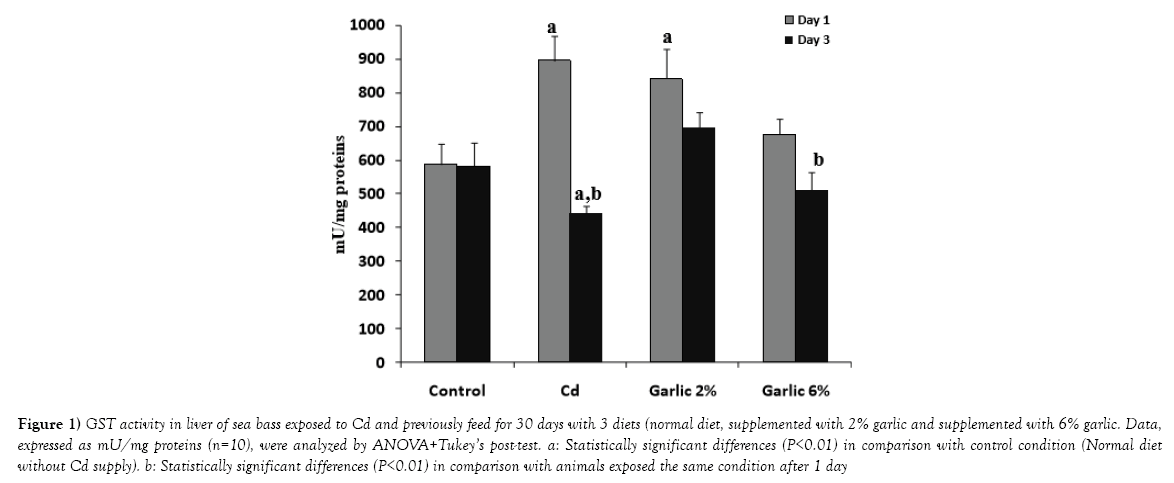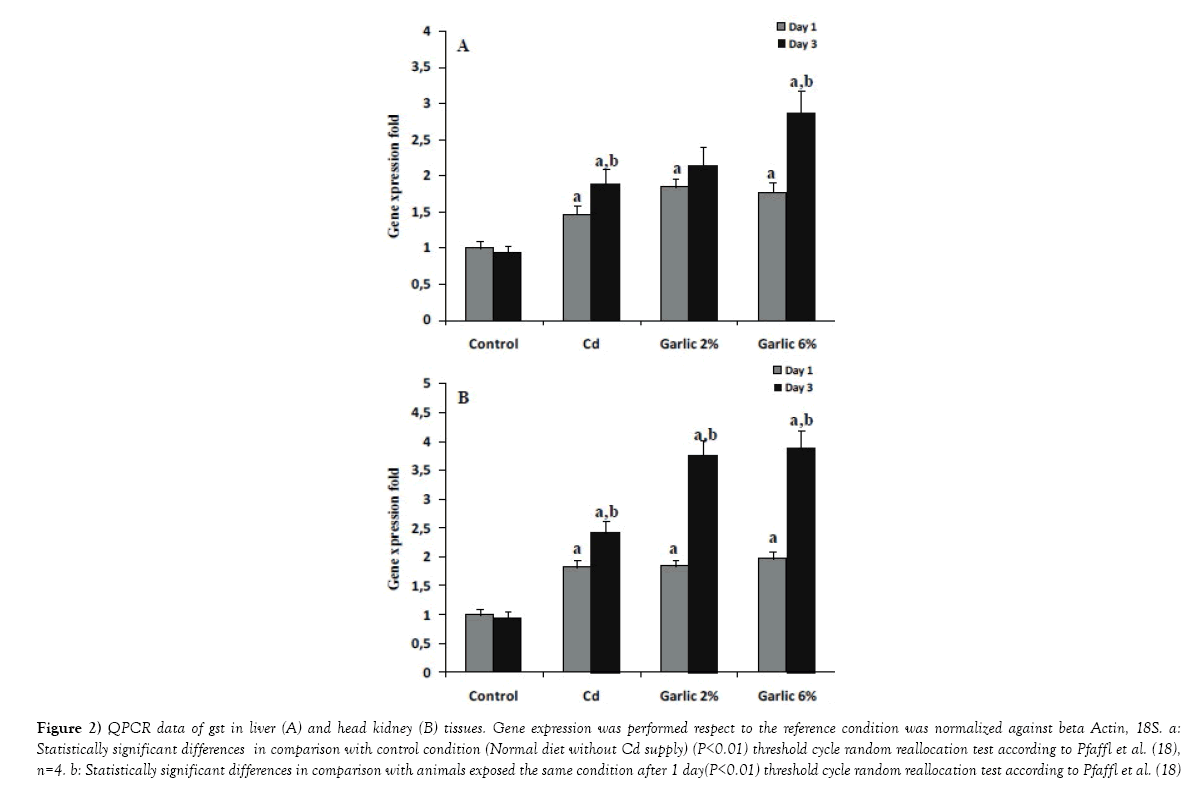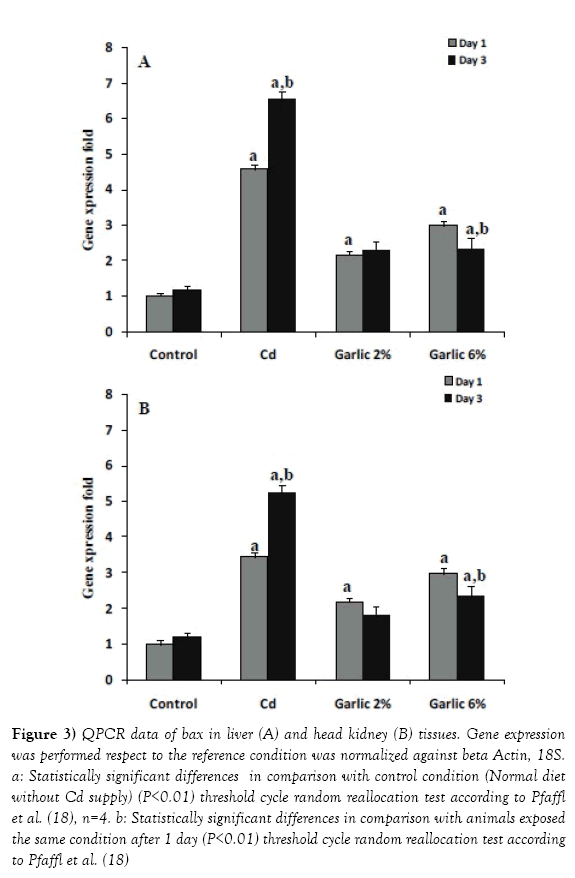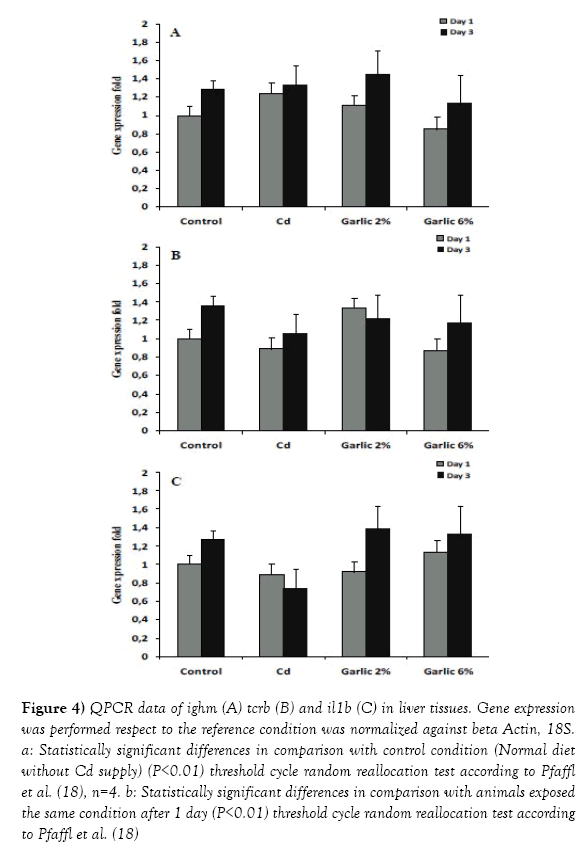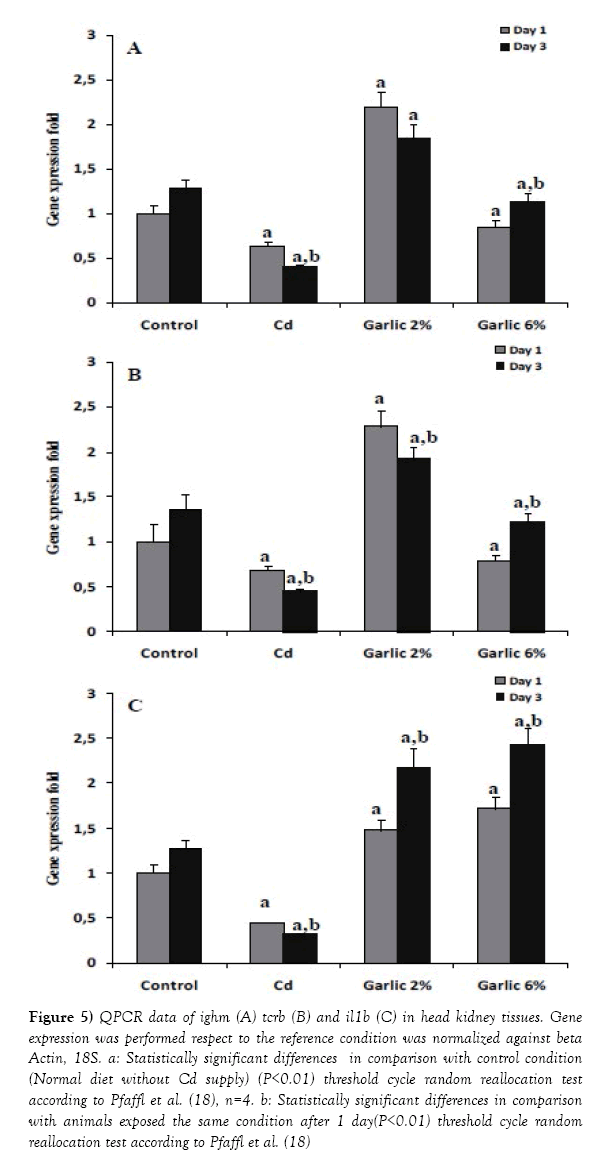Effects of dietary garlic against cadmium induced immunotoxicity in sea bass head, kidney and liver tissues: A transcriptomic approach
2 Institut National des Sciences et Technologies de la Mer, Laboratoire de Biotechnologie Bleu et Bioproduits Aquatiques, Salambo, 1002, Tunis, Tunisia, Email: Hamadi_Guerbej@gmail.com
Received: 11-Aug-2017 Accepted Date: Aug 22, 2017; Published: 29-Oct-2017
This open-access article is distributed under the terms of the Creative Commons Attribution Non-Commercial License (CC BY-NC) (http://creativecommons.org/licenses/by-nc/4.0/), which permits reuse, distribution and reproduction of the article, provided that the original work is properly cited and the reuse is restricted to noncommercial purposes. For commercial reuse, contact reprints@pulsus.com
Abstract
The knowledge about the protective effects of garlic against heavy metals on fish immunotoxicity is very limited. Juvenile sea bass specimens where maintained under three food diets (diet1: normal without garlic supply, diet 2: 2% garlic powder; diet 3: 6% garlic powder). After 30 days of specific diets, each group was injected with 500 µg.kg-1of Cd. Glutathiones-transferase activity (GST) as well as its related gene expression (gst) levels were monitored after 1 and 3 days of Cd injection in liver and head kidney tissues. Moreover, the gene expression profile of genes related to apoptosis (Bcl2 associated X protein; bax) and immune response (heavy chain of immunoglobulin M (ighm), T-cell receptor beta chain (tcrb) and interleukin-1 beta (il1b)) were investigated in both tissues. 2% garlic powder specific diet reversed the Cd-induced inhibition of GST in liver and significantly promoted the upregulation of gst in liver and head kidney. While, Cd induced a significant up-regulation of bax and a down regulation of immune related genes in the investigated tissues, garlic diet rendered a reversion of the later effects. This study provides a transcriptomic approach for elucidating the protective effects of garlic against Cd toxicity, and particularly the immunotoxicity, in fish head kidney and liver.
Keywords
Cadmium; Garlic; Gene expression; Apoptosis; Immune response; Sea bass
Contamination by heavy metals, such as cadmium (Cd) in the marine environment is a severe problem since this pollutant is very persistent [1]. Cd often released simultaneously in the environment from a number of natural and man-made sources. Indeed, the weathering of rocks releases cadmium to soils and aquatic systems. However, the main anthropogenic sources are industrial activities located along with the coastal lines [2]. Cd is a heavy metal of high environmental relevance, because it has been shown to produce long-term adverse effects to aquatic organisms [3,4]. Among the negative effects, Cd can lead to mortality, alterations in metabolic parameters, development and immunodeficiency in fish [5]. Plant products have been reported to increase various activities like anti-stress, growth promotion and immunostimulation in aquaculture activities [6,7]. Garlic (Allium sativum) is a perennial bulb-forming plant that belongs to the genus Allium in the family Liliaceae. Garlic has been a subject of considerable interest for centuries as a flavoring agent, traditional medicine, and a functional food to enhance physical and parameters. Garlic was studied in different forms of extracts: aqueous, ethanol and dried powder [8]. More recently, garlic extracts was usefully used to enhance fish growth and to counterbalance toxic effects of heavy metals [9].
Besides classical biomarkers of toxicity such as oxidative stress or genotoxicity, other studies indicated the impact of Cd on the ecosystem and organism health suggesting the importance of including new markers. Thus, the fish immune system could be considered as a nonspecific marker for environmental monitoring since it could have direct implications at individual and population levels [10].
The gene expression regulation of targets involved in oxidative stress (Glutathione-S Transferase), cell death (such as caspase 3 and Bcl-2 associated X protein), and immunity (pro-inflammatory cytokines, lymphocyte markers, tumour necrosis factor-a) has been evaluated in sea bass tissues [5,11] as well as in rainbow trout (Oncorhynchus mykiss) macrophages exposed to heavy metals [12]. However, to our knowledge there is no report indicating the protective effect of garlic against Cd induced toxicity at the immune response as well as the apoptosis processes. Therefore, studies are needed to clarify the toxicological effects and mechanisms of garlic protective effects against Cd induced toxicity in fish tissues.
The therapeutic efficacy of garlic and its curative prospective against the adverse effects of Cd at cellular and physiological levels in fish species in general and more in particular in farming activities can provide a scientific basis to elaborate strategies for diet formulation aiming to promote defense mechanisms such as immune response. Moreover, farming area all over the world suffer from water quality scarcity in term of xenobiotics contamination such as heavy metals.
The present study is conducted to evaluate the protective effect of garlic powder based diets on Cd induced toxicity in sea bass tissues. The phase II and oxidative stress related enzyme GST activity was first evaluated in sea bass liver. Second, based on available DNA sequence information for sea bass, we investigated the gene expression regulation of gst, Bcl2 associated X protein (bax) heavy chain of immunoglobulinM (ighm), T-cell receptor beta chain (tcrb) and interleukin-1 beta (il1b) genes using quantitative reverse-transcription PCR (qRT-PCR).
Materials and Methods
Animals, experimental conditions and sampling
All the procedures involving animals are in compliance with the care and use guidelines of experimental animals established by the Ministry of Higher Education and scientific research of Tunisia and the study was approved by the ethics committee of Monastir University. Moreover, this experiment was directed by accredited scientists (following FELASA category C recommendations) and conducted according to the European Union Directive (2010/63/EU) on the protection of animals for scientific purposes. Specimens of sexually immature sea bass (Dicentrachus labrax) of 60-70 g farmed at the aquaculture farm of the “Institut National des Sciences et Technologie de la Mer” (Monastir, Tunisia) were used. Fishes were acclimated for 15 days to laboratory conditions in a 1000 L aquarium filled with clean seawater maintained constantly at 16°C. Food was automatically distributed daily ensured as a 1.5% body mass ratio, with extruded pellet for marine fish (Table 1). Three diets differing in garlic content were formulated (normal diet; diet 1, supplemented with 2% garlic powder: diet 2 and supplemented with 6% garlic powder: diet 3). After the acclimation period, fishes were divided into 3 groups: control group (fed with normal diet: diet 1), 2% garlic powder supplied fish (diet 2) and 6% garlic powder supplied fish (diet 3). Each group was made of 100 specimens. Garlic was used as powder form to maximize its incorporation in the fish food and to maintain all the beneficial components. After a 30 days specific diet, each group was dived into two sub groups (intraperitoneally injected (0.2 μl/g) with cadmium and intra-peritoneally injected with NaCl 9% (0.2 μl/g). Cadmium (CdCl2) was solubilised in NaCl 9% and then adjusted to the desired concentrations (500 μg.kg-1). This concentration represents the 10% of the cadmium LC50 for sea bass [13]. After 24 h and 72 h of exposure, fishes were sacrificed and livers and head kidney were removed. Two sets of samples made of 10 individual tissues each obtained from different fishes were considered. The first batch was washed briefly in ice-cold homogenizing buffer and frozen at -80°C until enzymatic analysis. The second set of tissues was placed in RNA Later solution and stored at –80°C until gene expression analysis.
| Ingredient | Proportions |
|---|---|
| Crude proteins (%) | 45 |
| Crude fats (%) | 17 |
| Crude fibers (%) | 2,9 |
| Ashes (%) | 7,5 |
| Digestible energry (MJ/kg) | 18 |
| Minerals (%) | 1,11 |
| P (%) | 1,5 |
| Ca (%) | 1,5 |
| Na (ppm) | 0,32 |
| Cu sulfate (E4) (ppm) | 1 |
| Mn oxyde (E5) (ppm) | 8 |
| Zn oxde (E6) (ppm) | 50 |
| Se (ppm) | <0,05 |
| Vitamines | |
| Vit A (E672) (IU/kg) | 10 000 |
| Vit E (E671) (IU/kg) | 500 |
Table 1: Composition of the normal diet (without garlic powder supply)
Biochemical analysis
Before biochemical analysis, livers were homogenized in phosphate buffer (0.1 M, pH 7.5). The homogenate obtained was centrifuged at 9000 g for 25 Mn at 4°C for S9 fractions or at 20000 g 25 Mn at 4°C for S20. S9 fraction was used to carry out glutathione-S-Transferase activity (EC 2.5.1.18) analysis. The quantities of proteins present in S9 fraction were determined according to the Bradford et al. [14] using Coomassie Blue reagent. GST activity was measured in DG cytosol by the method of Habig et al. [15] using 10 μg of cytosolic protein, 1 mM 1-chloro-2,4-dinitrobenzene (CDNB) (Sigma-Aldrich, Saint Louis, MO, USA) as substrate, and 4 mM glutathione reduced form GSH , in 100 mM sodium phosphate buffer, pH 7.5. GST activity was determined by kinetic measurement at 20°C using a Jenway 6105 spectrophotometer (λ=340 nm). Results were expressed as mU GSH-CDNB produced per mg protein.
Gene expression
Total RNA was extracted from individual liver pieces using acid phenolchloroform precipitation Banni et al. [16] with TRI-Reagent (Sigma-Aldrich). RNA was further purified by precipitation in the presence of 1.5 M LiCl2 and the quality of each RNA preparation was confirmed by UV spectroscopy and TBE agarose gel electrophoresis in the presence of formamide. The mRNA abundances of the genes encoding Glutathione-s-transferase (GST).
Bcl2 associated X protein (bax), heavy chain of immunoglobulinM (ighm), T-cell receptor beta chain (tcrb) and interleukin-1 beta (il1b) were evaluated in multiplex Taqman assays Banni et al. [17]. Probes and primer pairs (Table 2) were designed using Beacon Designer v3.0 (Premier Biosoft International, Inc.). cDNA (25 ng RNA reverse-transcribed to cDNA) was amplified in a CFX384 Real-Time PCR detection system (Bio-Rad Laboratories) with iQTM Multiplex Power mix (Bio-Rad Laboratories) according to the manufacturer’s instructions for the triplex protocol. Briefly, cDNA was amplified in the presence of 1X iQTM Multiplex Power mix, 0.3 μM each primer, and 0.1 μM each probe (Table 2) in a final volume of 10 μL. Relative expression data were geometrically normalized to18S rRNA (AY831388), an invariant beta actin isotype (AJ537421.1) [16], which were selected from a list of genes whose expression did not vary over more than 50 conditions (including toxic treatments, stages of the life cycle, and various tissues). For all Taqman assays, the thermal protocol was as follows: 30 s at 95°C, followed by 40 cycles of 10 s at 95°C and 20 s at 60°C. qRT-PCR was performed with four biological replicates and three technical replicates. For the mt-a, assays, the thermal protocol was as Pfaffl et al. [18]. Statistical analyses were carried out on the group mean values using a random reallocation test [19].
| Gene _ID | Probe | Sense Primer | Antisense Primer |
|---|---|---|---|
| Bax (FM011848.1) | ATCAGGTGTCTTTCTTGTTCAGC | TGTCGACTCGTCATCAAAGC | CACATGTTCCCGGAGGTAGT |
| Ighm (FN908858.1) | CTACACACCCTTAACCACTGTCT | AGGACAGGACTGCTGCTGTT | CACCTGCTGTCTGCTGTTGT |
| Tcrb (FN687461.1) | TGGGAGATGTAACTGCAGGA | GACGGACGAAGCTGCCCA | TGGCAGCCTGTGTGATCTTCA |
| Il1b (AJ269472.1) | TCTCCTCATTGCCTCCTTTT | CAGGACTCCGGTTTGAACAT | GTCCATTCAAAAGGGGACAA |
| gst (DT044993.1) | TCCTGATGGCGAGCCCTACAAGCG | TCCTGGAACTTTGAGAAGTTCCT | GCACACTTTACTTGACCTT |
| actin (AJ537421.1) | TGACCTGTCCGTCAGGCAGCTCGT | CAAGGAGAAACTGTGCTATGTCG | GAACCTCTCATTGCCGATGGT |
| 18S (AY831388) | AGTAAGCTTACAGACGGGATAACG | GGATGCGTGCATTTATCAGA | GTCCCATGGTAGGCTCAGAA |
Given are: Gene ID, EMBL or NCBI gene Identifier; Taqman probe, sense primer and antisense primer sequences All sequence are given 5' to 3'
Table 2: Q-PCR primers and Taqman probes
Statistical analysis
The results for enzymatic activities are presented as the mean ± SD of 10 samples. The Statistica Software, version 6.0, computer software package (Statsoft. Inc. 2002) was used for statistical analysis. The normality of the distribution was tested using the Shapiro-Wilk test.
To assess multiple comparisons, a parametric one-way analysis of variance (ANOVA) was performed on data, with a Tukey’s test.
Results
Effects of Cd and garlic diet on GST activity
The phase II and antioxidant enzyme termed as GST significantly increased after 24 h and further decreased after 3 days in liver of animals injected with Cd and fed for 30 days with normal died (Figure 1). Interestingly a recovered to control values of GST activity was observed after 3 days in fish previously fed with 2% garlic. However, 6% garlic diet was not efficient to restore GST activity after 3 days of Cd injection.
Figure 1: GST activity in liver of sea bass exposed to Cd and previously feed for 30 days with 3 diets (normal diet, supplemented with 2% garlic and supplemented with 6% garlic. Data, expressed as mU/mg proteins (n=10), were analyzed by ANOVA+Tukey’s post-test. a: Statistically significant differences (P<0.01) in comparison with control condition (Normal diet without Cd supply). b: Statistically significant differences (P<0.01) in comparison with animals exposed the same condition after 1 day
Effects of Cd and garlic diet on GST gene expression in liver and head kidney
The gene expression pattern of gene encoding phase II enzyme gst is reported in Figure 2A. While GST gene expression in liver was maintained at control levels in animals injected with Cd and fed with normal diet, it was significantly up-regulated in animals maintained under garlic powder diet (2 and 6%) after 24 h and 3 days of Cd injection. The same pattern of gene expression but being more pronounced was observed in head kidney (Figure 2B).
Figure 2: QPCR data of gst in liver (A) and head kidney (B) tissues. Gene expression was performed respect to the reference condition was normalized against beta Actin, 18S. a: Statistically significant differences in comparison with control condition (Normal diet without Cd supply) (P<0.01) threshold cycle random reallocation test according to Pfaffl et al. (18), n=4. b: Statistically significant differences in comparison with animals exposed the same condition after 1 day(P<0.01) threshold cycle random reallocation test according to Pfaffl et al. (18)
Effects of Cd and garlic diet on apoptosis related gene (bax) mRNA expression
The gene expression regulation of bax in liver and head kidney of sea bass
Effects of dietary garlic against cadmium induced immunotoxicity in sea bass head
maintained under different garlic powder based diets and injected with Cd is reported in Figure 3. Our data indicated a significant up-regulation of bax in animals fed with control diet and injected with Cd. The maximum was observed after 3 days with up to 6.55 folds. Despite the maintained up regulation pattern, gene expression level was reduced in animals fed with 2% and 6% based diet. The minimum gene expression level was observed in head kidney with only 1.78 folds when compare to control animals.
Figure 3: QPCR data of bax in liver (A) and head kidney (B) tissues. Gene expression was performed respect to the reference condition was normalized against beta Actin, 18S. a: Statistically significant differences in comparison with control condition (Normal diet without Cd supply) (P<0.01) threshold cycle random reallocation test according to Pfaffl et al. (18), n=4. b: Statistically significant differences in comparison with animals exposed the same condition after 1 day (P<0.01) threshold cycle random reallocation test according to Pfaffl et al. (18)
Effects of Cd and garlic diet on selected immune related genes mRNA expression
Expression analysis of various genes (ighm, tcrb, il1b) encoding immune response proteins was performed by real time quantitative PCR on liver and head kidney transcripts using 18S rRNA and beta-actin as reference genes (Figures 4 and 5). While no significant gene expression regulation of immune related targets was recorded in liver (Figure 4), an intesrting pattern was reported in head kidney (Figure 5). Indeed, in fish fed with normal diet and injected with Cd, the three targets were dramatically down regulated after 1 and 3 days when compared to control values. Interestingly, in animals fed for 30 days with 2% garlic powder based diet a significant up-regulation in ighm and il1b transcription was observed after 1 day and 3 days. However, animals fed with 6% garlic manifested a return to control values of the investigated targets. The pattern of tcr target showed a significant upregulation in animals fed with 2 and 6% garlic powder with a maximum registered after 3 days in animals fed with 6% diet and injected with Cd with a value of 2.43 folds.
Figure 4: QPCR data of ighm (A) tcrb (B) and il1b (C) in liver tissues. Gene expression was performed respect to the reference condition was normalized against beta Actin, 18S. a: Statistically significant differences in comparison with control condition (Normal diet without Cd supply) (P<0.01) threshold cycle random reallocation test according to Pfaffl et al. (18), n=4. b: Statistically significant differences in comparison with animals exposed the same condition after 1 day (P<0.01) threshold cycle random reallocation test according to Pfaffl et al. (18)
Figure 5: QPCR data of ighm (A) tcrb (B) and il1b (C) in head kidney tissues. Gene expression was performed respect to the reference condition was normalized against beta Actin, 18S. a: Statistically significant differences in comparison with control condition (Normal diet without Cd supply) (P<0.01) threshold cycle random reallocation test according to Pfaffl et al. (18), n=4. b: Statistically significant differences in comparison with animals exposed the same condition after 1 day(P<0.01) threshold cycle random reallocation test according to Pfaffl et al. (18)
Discussion
Actually, ecological challenges are running high as animal and human health concerns emerge as unexpected consequences of the marine pollution and are increased in a context of continual anthropogenic discharges and seawater quality alteration. Fish and in particular those produced in aquaculture systems are among the most exposed to environmental contaminants such as Cd. Thus the researches of alternative to counterbalance these negative effects are of great interest. Regarding this last aspect, increasing attention has been paid to the immune system of fish as an indicator of exposure to environmental pollutants [20]. Most immunological research involving fish species has been concerned with either their phylogenetic or economic importance.
In our study, fish were exposed to 500 μg/kg, thus considering that animals used for this study are around 50 g each, and the nominal exposure concentration would be 25 μg/animal. This concentration was Thophon et al. [13] as the 10% of the LC50. This particular concentration was selected to conduct this experiment since its toxic effect is expected, thus the possible protective effect to garlic based diet could be validated. Exposure to Cd clearly decreased the activity of GST after 7 days in fishes fed with the normal diet. However, a recover to control values in some cases and a significant increase of the anti-oxidant enzymes was recorded in animals previously maintained under garlic powder added food (2% and 6%). In the same experiment we demonstrated that animals fed with 2% garlic supplement MDA accumulation was recovered to control values [10]. Concomitly our research group reported an increase in Cd as well as Zinc and Selenium loads in animals injected with Cd and maintained under 2 and 6% garlic powder based diet [10].
GST induction occurs in several tissues of fish at different periods of exposure to inducers, this depending on the type of tissue and nature of the inducer [1]. The early event of GST stimulation by xenobiotics such as heavy metals in liver has been described at 18-24 h after administration [21]. Moreover, some studies found an earlier and a maintained activation of GST in sea bream liver after acute exposure to Cd during 48 h. The relationship between GST protein levels and activity, as a response to Cd has been studied in several laboratories. An investigation by the Agency for Toxic Substances and Disease Registry, USA, to evaluate the toxicity of some metals showed that in mammalian cells 48 h after exposure, Cd2+ exhibited a significant dose-dependent transcriptional activation capacity of various GST isoenzymes [22]. Genomics-based approaches have allowed a unique view into the mechanisms underlying suites of metabolic processes. Notably, transcriptomics, the simultaneous measurement of thousands mRNAs in a biological sample, has proved to be a robust tool, enhancing our understanding of many important physiological processes in marine biosystems [3,23].
In this regard we investigated the gene expression regulation of a set of genes related to Phase II biotransformation, apoptosis and immune response in two metabolically and immunological relevant tissues; liver and head kidney. In general, our data suggested a restored gene expression level in some case to control values and in other cases a significant up-regulation in animals fed with garlic based diet and injected with Cd when compared to control animals and to animals injected with Cd but maintained under normal diet. Interestingly, the gene expression pattern of gst was in trend with the related enzymes activities in liver. Moreover, a maintained up-regulation pattern was observed in head kidney in all the experimental conditions being more pronounced in animals injected with Cd and maintained under garlic powder based diet. It is possible that in the present work, the increase in the transcription gst and other anti-oxidant enzymes largely contribute to the elimination of ROS from the cell induced by Cd exposure [24].
In this paper we tested whether the expression of immune genes in liver and head kidney cells was altered. Thus, heavy chain of immunoglobulinM (ighm), T-cell receptor beta chain (tcrb), interleukin-1 beta (il1b), were analysed after 24 h and 3 days exposure of sea bass to Cd in animals maintained for 30 days under specific diets. In the same context gene expression patter of bax; a well-known gene involved in cellular apoptosis was monitored at the different experimental conditions. Cd injection resulted in a dramatic up-regulation of bax in tissues of animals fed with normal diet. This up-regulation was significantly reduced but remained different in animals fed with garlic based diet respect to control fish. However, ighm, tcrb, and il1b targets were dramatically down regulated in head kidney of fish injected with Cd, suggesting a depletion of the immune response in these animals. Interestingly, in animals fed for 30 days with 2% and 6% garlic powder, we observed an opposite trend with a significant up-regulation of the latter targets. This may suggest for the first time that garlic restored and exerted a protective effect of the immune response related genes in animals exposed to Cd. Similarly and focusing on the immunotoxicological effects, it has been demonstrated that in vitro exposure of catfish (Ictalurus melas) nonspecific cytotoxic cells (NCCs) to different concentrations of soluble Cd inhibited their ability to kill human tumor cells [25]. Moreover, European sea bass (Dicentrarchus labrax) leucocytes reduced their phagocytosis by in vitro exposure to heavy metals [26,27].
The idea of reversing toxicant induced toxicity by adding essential trace elements highly present in garlic composition was tested successfully in mammalian systems. Indeed, Messaoudi et al. [24] reported the protective effect of zinc against cadmium-induced testicular pathophysiology in rat. Moreover, the same research group demonstrated the protective effects of selenium, zinc or their combination on cadmium-induced oxidative stress in rat kidney [28] and rat erythrocytes [24].
Conclusion
As a conclusion, in fish farming activities, immune system is often promoted and reinforced using classical therapeutic methods with all the adverse effect that this may constitute in term of residues on the consumer’s health. Our results of demonstrated that sea bass liver and head kidney immune response are seriously affected by Cd exposure and that a garlic powder based diet can prevent against these alterations. This funding can be optimized in the fish diet formulations introducing natural extracts such as garlic powder, thus preventing against unexpected effect on fish consumers. Moreover, the insufficient available data on the use of plant extracts to protect against fish alterations due to environmental stressors legitimate our research. Additional studies are still required to understand the mechanisms involved the immunotoxicological effects of Cd and the implication of garlic use on fish biology in general and its impacts in aquaculture activities.
Acknowledgements
This work was supported by funds from the and the Ministry of Scientific Research and Technology, Tunisia (Unité de Recherche en Biochimie et Toxicologie Environnementale), ISA Chott-Mariem.
Conflict of Interest
Authors declare that there is no conflict of interest.
REFERENCES
- Bouraoui Z, Banni M, Ghedira J, et al. Acute effects of cadmium on liver phase I and phase II enzymes and metallothionein accumulation on sea bream Sparus aurata. Fish Physiol Biochem. 2008;34(3):201-7.
- Nriagu J, Pacyna J. Quantitative assessment of worldwide contamination of air, water and soils by trace metals. Nature. 1988;333:134-9.
- Banni M, Messaoudi I, Said L, et al. Metallothionein gene expression in liver of rats exposed to cadmium and supplemented with zinc and selenium. Arch Environ Contam Toxicol. 2010;l59(3):513-9.
- Satarug S, Vesey DA, Gobe GC. Current health risk assessment practice for dietary cadmium: Data from different countries. Food Chem Toxicol. 2017;106:430-45.
- Morcillo P, Cordero C, Meseguer J, et al. In vitro immunotoxicological effects of heavy metals on European sea bass (Dicentrarchus labrax L.) head-kidney leucocytes. Fish Shellfish Immunol. 2015;47:245-54.
- Citarasu, T, Sekar RR, Babu MM, et al. Developing artemia enriched herbal diet for producing quality larvae in Penaeus monodon. Asian Fish Sci. 2002;15:21-32.
- SivaramV, Babu MM, Immanuel G, et al. Growth and immune response of juvenile greasy groupers (Epinephelus tauvina) fed with herbal antibacterial active principle supplemented diets against Vibrio harveyi infections. Aquaculture. 2004;237:9-20.
- Shin SH, Kim MK. Effect of dried powders or ethanol extracts of garlic flesh and peel on lipid metabolism and antithrombiogenic capacity in 16-month-old rats. J Nutr Health. 2004;37:515-524.
- Mosbah A, Guerbaj H, Boussetta H, et al. Protective effects of dietary garlic powder against cadmium induced toxicity in sea bass liver: A chemical, biochemical and transcriptomic approach. Biol Trac Elem Res. 2017;1146-4.
- Bado-Nilles A, Jolly S, Porcher JM, et al. Applications in environmental risk assessment of leucocyte apoptosis, necrosis and respiratory burst analysis on the European bullhead, cottus. Environ Pollut. 2014;184:17.
- Vazzana M, Celi M, Tramati C, et al. In vitro effect of cadmium and copper on separated blood leukocytes of Dicentrarchus labrax, ecotoxicol. Environ Saf. 2014;102:113-20.
- Teles M, Mackenzie S, et al. Gene expression and TNF alpha secretion profile in rainbow trout macrophages following exposures to copper and bacterial lipopolysaccharide. Fish Shellfish Immunol. 2011;30:340-6.
- Thophon S, Kruatrachue M, Upatham ES, et al. Histopathological alterations of white sea bass, Lates calcarifer, in acute and sub chronic cadmium exposure. Environ Pollut. 2003;121(3):307–20.
- Bradford M. A rapid and sensitive method for the quantification of microgram quantities of protein utilizing the principle of protein-dye binding. Anal Biochem. 1976;72:248-54.
- Habig WH, Pabst MJ, Jakoby WB. Glutathione S-transferases, the first step in mercapturic acid formation. J Biol Chem. 1974;249:7130-9.
- Banni M, Hajer A, Sforzini S, et al. Transcriptional expression levels and biochemical markers of oxidative stress in Mytilus galloprovincialis exposed to nickel and heat stress. Comp Biochem Physiol C Toxicol Pharmacol. 2014;160:23-9.
- Dondero F, Piacentini L, Banni M, et al. Quantitative PCR analysis of two molluscan metallothionein genes unveils differential expression and regulation. Gene. 2005;345:259-70.
- Pfaffl MW, Horgan GW, Dempfle L. Relative expression software tool (REST) for group wise comparison and statistical analysis of relative expression results in real-time PCR. Nucleic Acids Res. 2002;30:36.
- Waisberg M, Joseph P, Hale B, et al. Molecular and cellular mechanisms of cadmium carcinogenesis. Toxicology. 2003;192:95-117.
- Zelikoff JT, Bowser D, Squibb KS, et al. Immunotoxicity of low level cadmium exposure in fish: An alternative animal model for immunotoxicological studies. J Toxicol Env Health. 1995;45:235-48.
- Lamb JG, Franklin MR. Early events in the induction of rat hepatic UDP glucuronosyl- transferase, glutathione S-transferase and microsomal epoxide hydrolase by 1,7-phenanthroline: comparison with oltipraz, tert-butyl-4-hydroxyanisole and tertbutylhydroquinone. Drug Metab Dispos. 2000;28:1018-23.
- Tully DB, Collins BJ, Overstreet JD, et al. Effects of arsenic, cadmium, chromium, and lead on gene expression regulated by a battery of 13 different promoters in recombinant HepG2 cells. Toxicol Appl Pharmacol. 2000;168:79–90.
- Negri A, Oliveri C, Sforzini S, et al. Transcriptional response of the mussel Mytilus galloprovincialis (Lam) following exposure to heat stress and copper. PLoS ONE. 2013;10:1371.
- Messaoudi I, Hammouda F, El Heni J, et al. Reversal of cadmium-induced oxidative stress in rat erythrocytes by selenium, zinc or their combination. Exp Toxicol Pathol. 2010;62(3):281-8.
- Viola A, Pregnolato GAV. Effect of in vitro cadmium exposure on natural killer (NK) cells of catfish, Ictalurus melas. Fish Shellfish Immunol. 1996;6:167-72.
- Bennani A, Schmid-Alliana A, Lafaurie M. Immunotoxic effects of copper and cadmium in the sea bass Dicentrarchus labrax. Immunopharm Immunot. 1996;18;129-44.
- Sarmento A, Guilhermino L, Afonso A. Mercury chloride effects on the function and cellular integrity of sea bass (Dicentrarchus labrax) head kidney macrophages. Fish Shellfish Immunol. 2004;17:489-98.
- Messaoudi I, El Heni J, Hammouda F, et al. Protective effects of selenium, zinc or their combination on cadmium-induced oxidative stress in rat kidney. Biol Trace Elem Res. 2009;130(2):152-61.




